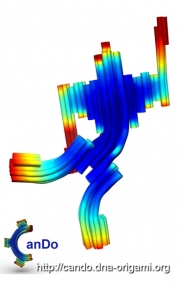New DNA origami program allows for more complex nanostructures
April 29, 2011

The CanDo program can convert a 2-D DNA origami blueprint into a complex 3-D shape, seen here (credit: Do-Nyun Kim)
An MIT team led by biological engineer Mark Bathe has developed computer-aided design software that makes it easier to create complex 3-D nanostructures, using DNA origami (for constructing shapes from a DNA strand ).
DNA origami is a scaffold, or building material for self-assembling nanoscale structures that could be used to deliver drugs, act as biosensors, perform artificial photosynthesis and more.
Bathe’s new software program, dubbed CanDo (computer-aided engineering for DNA origami), takes a 2-D blueprint and predicts the ultimate 3-D shape of the design. This resulting shape is often unintuitive, Bathe says, because DNA is a flexible object that twists, bends and stretches as it folds to form a complex 3-D shape.
Designing better drug-delivery systems
One possible application of scaffolded DNA origami is a “DNA carrier” that can transport drugs to specific destinations in the body such as tumors, where the carrier would release the cargo based on a specific chemical signal from the target cancer cell.
DNA origami could also help reproduce part of the light-harvesting apparatus of photosynthetic plant cells. Researchers hope to recreate that complex series of about 20 protein subunits, but to do that, components must be held together in specific positions and orientations. That’s where DNA origami could come in.
“DNA origami enables the nanoscale construction of very precise architectural arrangements. Researchers are exploiting this unique property to pursue a number of applications at the nanoscale, including a synthetic photocell,” Bathe says. “While applications such as this are still quite far off on the horizon, we believe that predictive engineering software tools are essential for progress in this direction.”
Novel applications of these tools may also grow out of a new competition being held at Harvard this summer, called BIOMOD. Undergraduate teams from about a dozen schools, including MIT, Harvard and Caltech, will try to design nanoscale biomolecules for robotics, computing and other applications.